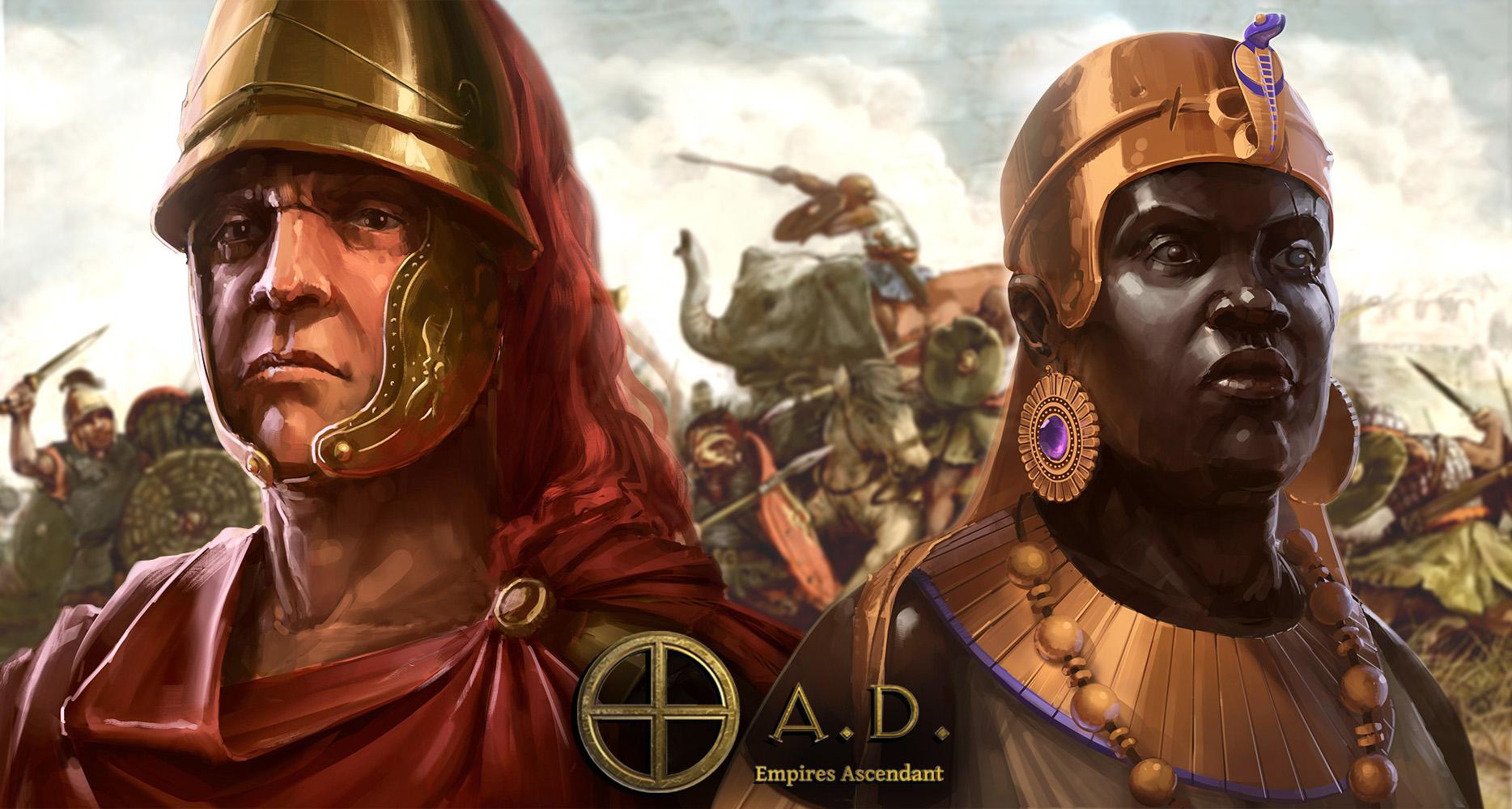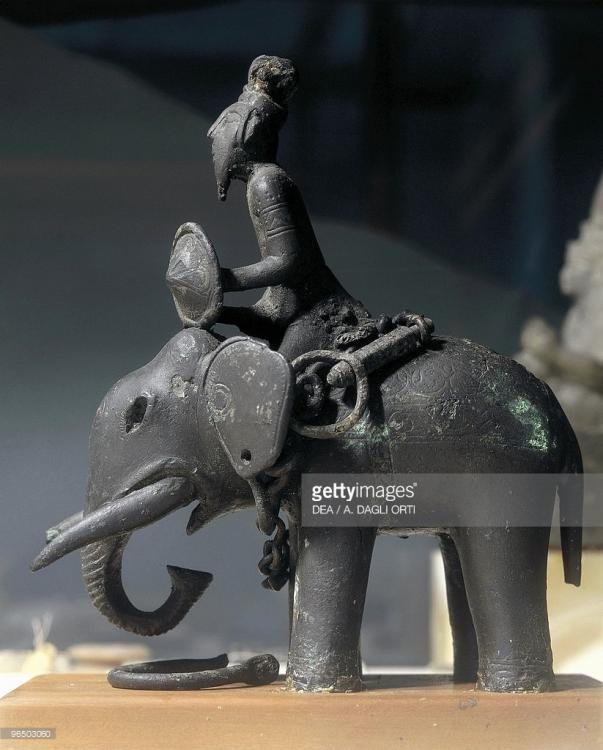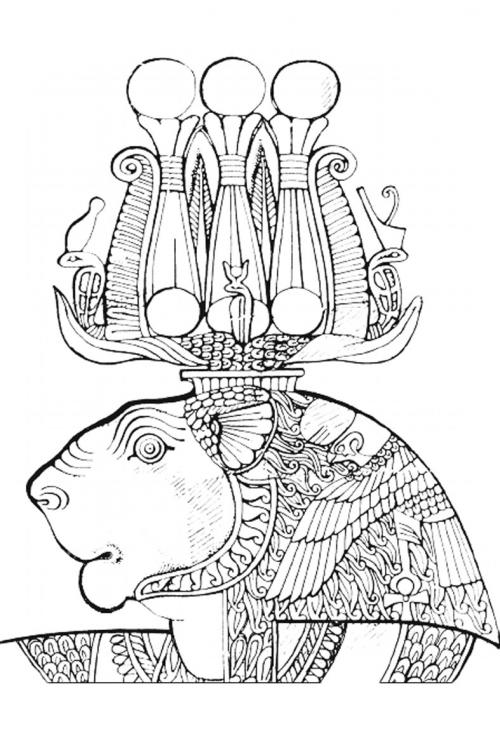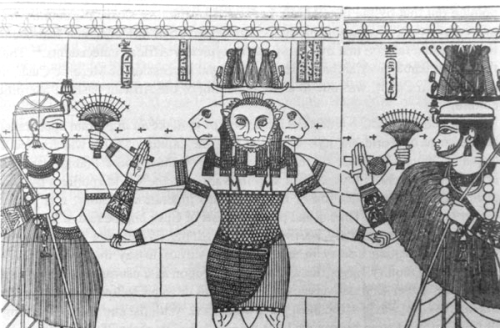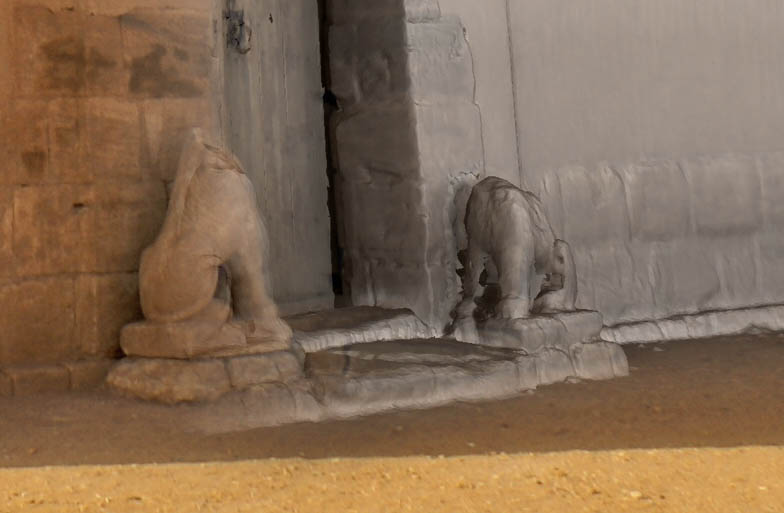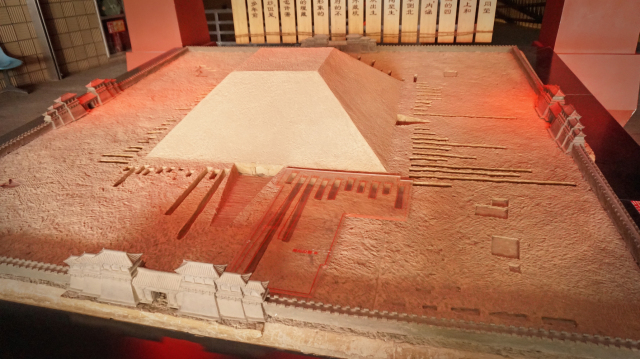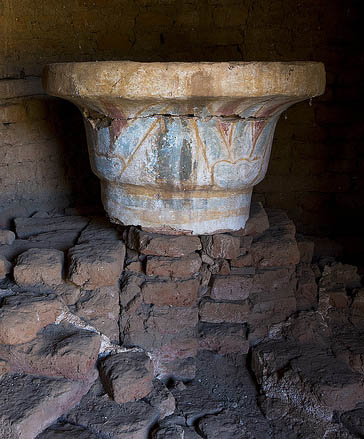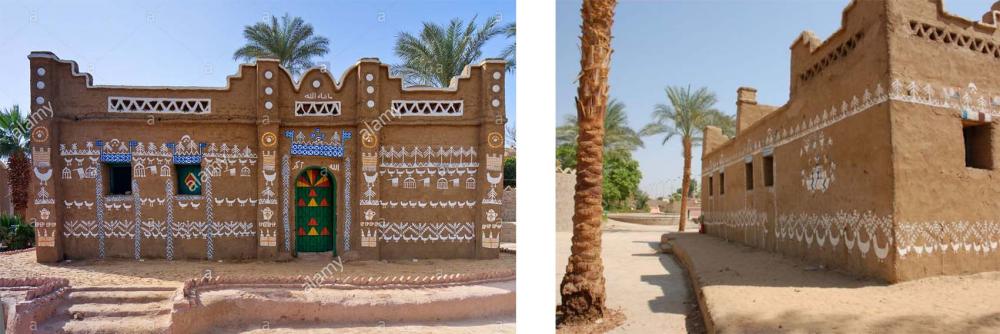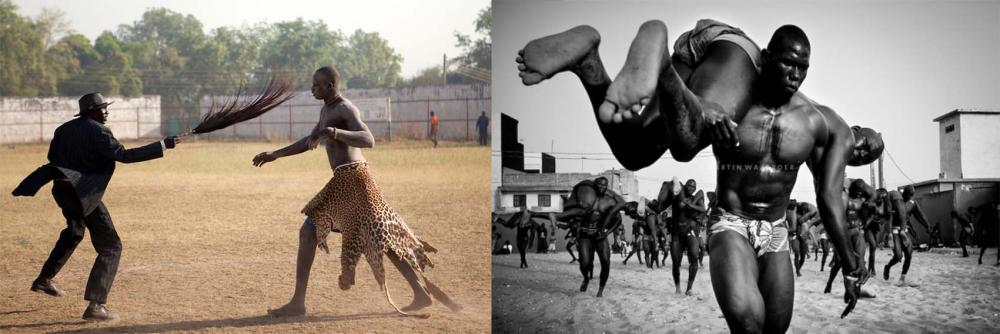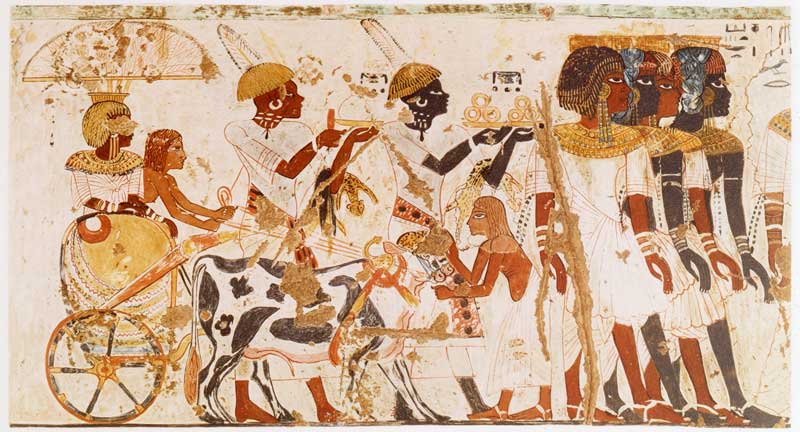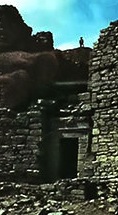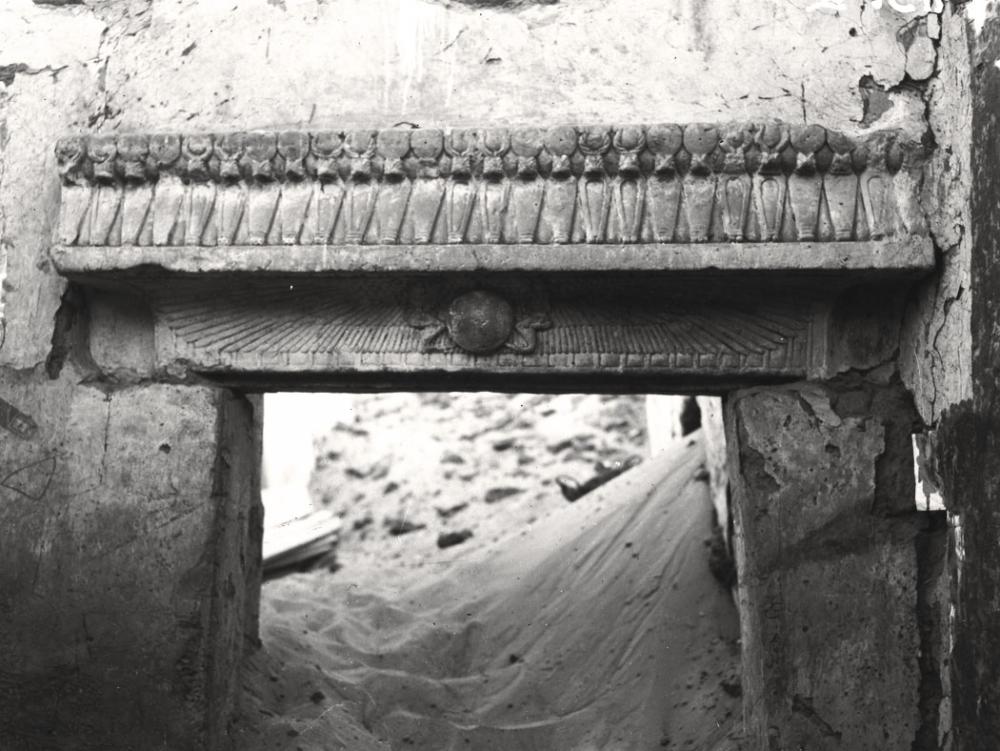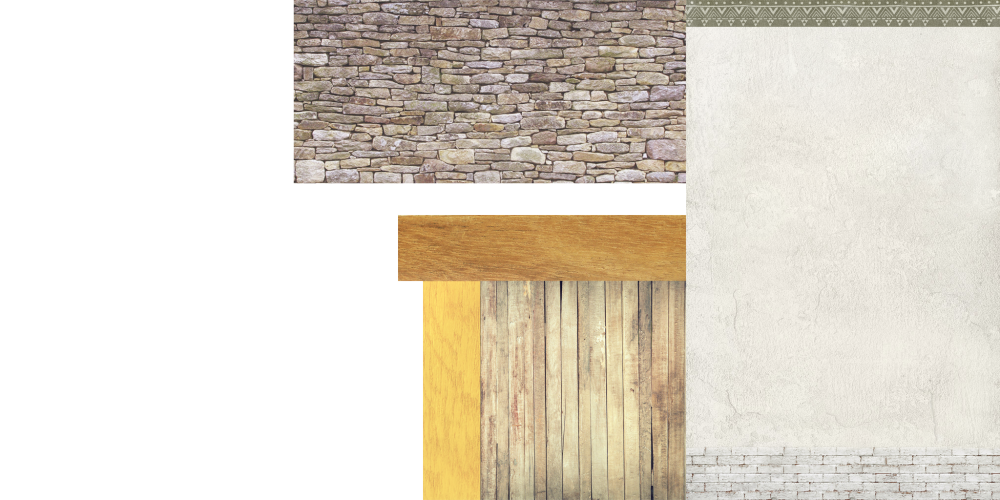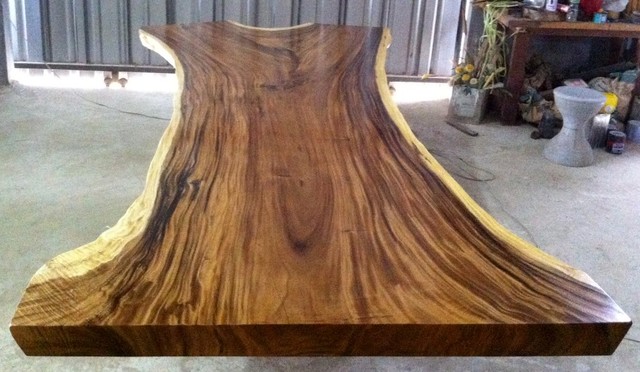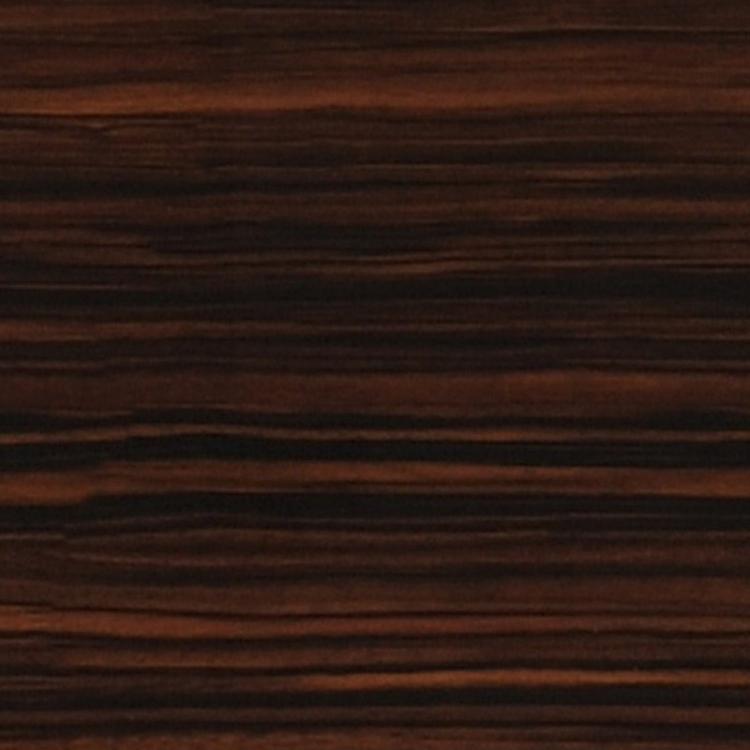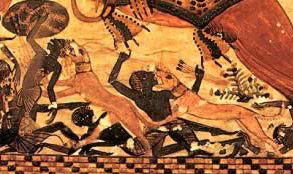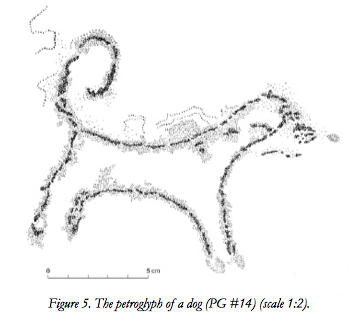-
Posts
2.332 -
Joined
-
Last visited
-
Days Won
60
Everything posted by Sundiata
-
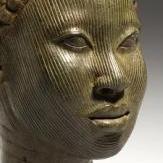
The Kingdom of Kush: A proper introduction [Illustrated]
Sundiata replied to Sundiata's topic in Official tasks
Actually, in terms of architectural style and features, LordGood has done an amazing job of modeling these buildings. They're very clearly Kushite. In terms of texture, Kushites used both white lime plaster, and mud-plaster. But white lime plaster was used quite extensively, especially during the more affluent periods (not unlike the Carthaginians). LordGood seems to have gone for a sort of midway option. It looks good for now, but might be eligible for change later, if LordGood or other artists contribute new textures for the texture pack. In terms of decorative paterns LordGood nailed it again. In terms of the "Egyptian feel", that will become more apparent with the temple (lion temple of Apedemak) and the special building (temple to Amun).- 1.040 replies
-
- 2
-

-
- civ profile
- history
- (and 5 more)
-

The Kingdom of Kush: A proper introduction [Illustrated]
Sundiata replied to Sundiata's topic in Official tasks
Sounds spicy… Care to elaborate? "Mybe a couple of Egyptian style column next to the front door of the barracks, flanked by 2 lions?" I kind of like this. fig. 114 Maybe the doorways can be flanked by kushite stela, inscribed with hieroglyphs, or Meroitic sccript, like this one (although the temple should also have some stela like this):- 1.040 replies
-
- civ profile
- history
- (and 5 more)
-

The Kingdom of Kush: A proper introduction [Illustrated]
Sundiata replied to Sundiata's topic in Official tasks
@niektb I have to admit, the pdf was all balduin... @balduin Thanks for the advice on downloading the pdf (took me 2 seconds). Reading through it is a breeze now. @Lion.Kanzen You're right, I have made mention of Indian influence, but for now, the only concrete evidence I've seen is the elephant statuette from Meroe (which depicts an Indian elephant). Other possible examples of this influence are some temple reliefs..- 1.040 replies
-
- 1
-

-
- civ profile
- history
- (and 5 more)
-

The Kingdom of Kush: A proper introduction [Illustrated]
Sundiata replied to Sundiata's topic in Official tasks
@LordGood Ok, so my thoughts on the models so far: Let me begin by saying they look great (as usual). The Farm building: As Balduin mentioned, the door shouldn't be as high in the building as it is now. Bringing the door down will make the structure look more impressive and realistic, and the access-ramp wouldn't look so awkwardly steep. Using brick seems more likely for the access ramp. And indeed, wooden barrels seem a little out of place. Large ceramic vessels, like the Hellenized amphora Balduin shared, or large round or oval pots would be used for storing certain produce. Not all buildings used vaulted ceiling or domes. Flat roofs were also used, and a flat roof for the extra building next to the silo on the farm building would be perfect (for drying fruits or something). It would make the rooftop functional, and justify the use of a ladder to reach that roof. The dropsite looks perfect, although I also think it has too many doors. Especially the back corner could loose one of it's two doors. Barracks look good, but I also think it should loose it's vaulted ceiling in favor of a flat roof (less ornate). A flat roof would make it look more aggressive. Those Egyptian style half-circles lining the roof, could then go all the way round the edge of buildings' rooftop, increasing it's military feel.. Maybe the courtyard could be a little bit bigger, to help with prop-placement. Is it possible to have a small archery range in front of the building (just a target, perhaps), or would that mess too much with the footprint of the building?- 1.040 replies
-
- 1
-

-
- civ profile
- history
- (and 5 more)
-

The Kingdom of Kush: A proper introduction [Illustrated]
Sundiata replied to Sundiata's topic in Official tasks
@LordGood Just… Wow… Amazing! I'll be sharing my thoughts and giving some headers by tonight. Loving the work so far!- 1.040 replies
-
- civ profile
- history
- (and 5 more)
-
I grew up playing Settlers III. In that game, you could recruit spies (people, not sheep). They would look like a spy to the player who recruited them, but to any AI or enemy, they would look like one of their own units, until they got too close to combat units that is, after which the disguise wouldn't work anymore, and your spy would be killed. Possible idea? Ps: players paying attention will notice these spies, because they behave differently from your own units (idle and then moving around without any commands from yourself).
-

The Kingdom of Kush: A proper introduction [Illustrated]
Sundiata replied to Sundiata's topic in Official tasks
I'm confident you'll come up with something nice… Artistic licenses will always have to be taken to some degree. I'm just being as specific as I can, so that it becomes clear what we know, and what we don't. CC is a known, so it doesn't need all that much interpreting.- 1.040 replies
-
- 1
-

-
- civ profile
- history
- (and 5 more)
-

The Kingdom of Kush: A proper introduction [Illustrated]
Sundiata replied to Sundiata's topic in Official tasks
@Tomcelmare Hi, thank you for joining the discussion! I have to disagree though, on a pyramidal brown roof for the CC. The Kushites had actual administrative centers, and we know where they are located and roughly how they looked like. They all follow a specific pattern. Large, nearly perfectly square, multistoried compounds, built over large vaulted cellars, with a central courtyard or light-well, lined by a colonnade, with columns topped by "papyrus shaped" capitols. Built using a combination of mud-brick foundation (plasticity equals stability), fired red brick, cut sandstone, and white lime-plaster (perhaps mud-plaster in some cases). Vaulted ceilings were common, arched windows for upper floors as well. Fig. 109 I recently found another example of a large 2 storied Kushite palace, with more archaic features. I didn't share it before, because I can't find the source of this picture. All I know is It came from a forum discussing Kushites. Perhaps Amanishakheto's palace at Naqa?- 1.040 replies
-
- 2
-

-
- civ profile
- history
- (and 5 more)
-
One suggestion.. I don't know much about China, so correct me if I'm wrong, but I think Emperor Jing Di's mausoleum in Xi'an (2nd century BCE) might be a cool idea for a wonder. https://starksepicadventure.wordpress.com/2014/09/01/china-xian-tomb-of-emperor-jing-di/
-

The Kingdom of Kush: A proper introduction [Illustrated]
Sundiata replied to Sundiata's topic in Official tasks
@av93 Because the Meroitic language hasn't been deciphered yet, there are a lot of unknowns about the internal organization of Kush. This makes it a bit difficult to get info on the exact composition (or terminology) of armies, but we do know enough to create an extensive unit roster, based on reality (descriptions [the occasional non-meroitic text], historical depictions like reliefs and archaeological finds like weapons). I spent some time describing these here: (definitely try to take a look at the spoiler at the end) and here ("something on weapons and armor" towards the end) : My imgur albums dedicated to the subject of Kushite units: http://imgur.com/a/wK5MN http://imgur.com/a/HtBcc A collection of all the imgur albums I created in order to illustrate these posts: http://malcolmquartey.imgur.com- 1.040 replies
-
- civ profile
- history
- (and 5 more)
-

The Kingdom of Kush: A proper introduction [Illustrated]
Sundiata replied to Sundiata's topic in Official tasks
I agree completely. The educational aspect is important. When dealing with classical antiquity, there is a lot of Mediterranean-centered tunnel-vision. But 0AD does quite a good job of showcasing ancient diversity in cultures and civilizations. To be honest, I didn't even know about those AoE2 expansions until after I started reading about the Kushites for this project. I'm glad they eventually added them, but they were 16 years too late… In addition, those factions look wildly inaccurate. The 0AD community has already proven that they can do a [far] better job! @balduin I'll have to do a little more research, but I think you're idea's for the low wall are good. I'll be a little less active the coming days, because I'm moving back to Belgium for a few months tomorrow. Anyway, I'm very excited over the amount of interest and support in this mod. Can't wait to see what @LordGood cooks up next! But don't feel pressured to rush anything, you created those models at lightening-speed, and I wouldn't want you to burn out- 1.040 replies
-
- civ profile
- history
- (and 5 more)
-

The Kingdom of Kush: A proper introduction [Illustrated]
Sundiata replied to Sundiata's topic in Official tasks
Fig. 108 A well preserved example of a Meroitic papyrus capital from the Royal baths at Meroe, which would have topped a column (pillar). Would be nice for an entrance portico.- 1.040 replies
-
- 1
-

-
- civ profile
- history
- (and 5 more)
-

The Kingdom of Kush: A proper introduction [Illustrated]
Sundiata replied to Sundiata's topic in Official tasks
@LordGood Sweet Jesus, The Lord-is-Good! (pun intended) Wow, really amazing! I have no real comments on this… They look both Kushite, and in line with the general feel of the game. These models feel like they've always been a part of the game… My mouth is watering at the sight of them! @wowgetoffyourcellphone Yes, the designs might be a good idea for the player color… This would allow slightly more whitish buildings, as the designs would stand out more in the player color. I also like my own texture attempt, but the (lower) design LordGood used is actually from a (non-whitewashed) Nubian house (15e). I described it as contemporary, but it's actually on the grounds of the Nubian museum in Aswan. It's a traditional Nubian design. Fig. 105 Details on a traditional (non-whitewashed) Nubian house in the Nubian Museum, Aswan. @niektb Cool! @balduin Nuba (ethnically related to Meroites) are generally very tall and athletically built (slim to muscular) Fig 106 Nuba wrestlers @LordGood Check out the governors palace at Karanog (fig 14). Fig. 107 Meroitic governors' residence at Karanog (left), and palace at Wad Ben Naqa (center) and Naqa (right). These are literally town centers.- 1.040 replies
-
- 1
-

-
- civ profile
- history
- (and 5 more)
-

The Kingdom of Kush: A proper introduction [Illustrated]
Sundiata replied to Sundiata's topic in Official tasks
Haha, yes, of course, I was just brainstorming some ideas for the long term. Mini-factions are a really interesting idea, and could add a lot in terms of depth. They offer a lot of opportunities: historically linking civilizations through mutual neighbors, an alternate source of mercenaries once conquered, an obstruction to expansion and a buffer between you and a more powerful AI. Before dealing with overly aggressive early rushes from the AI, or expanding territory, you'd have to first pacify "the locals". But yes, let's first finish the Kushites- 1.040 replies
-
- 1
-

-
- civ profile
- history
- (and 5 more)
-
Interesting discussion. I also think there is still room for fleshing out the game a little more (especially economically). There should be a little more focus on strategy vs tactics. There should always be more than 1 viable way of attaining dominance (diplomatic and economy, as opposed to only naked military aggression). I also like the idea of trees regenerating. But it might spoil the balance. For longer games though, I think it makes a lot of sense. @Servo You are not the only one who plays like that. I can spend hours (even days) on a single map, building "cities" and smaller towns, outposts, harbors…. All the while toying with the AI set to hardest. But the AI seems to sort of give up, in the very late game. I also think that the maps start looking terrible, when totally deforested, and I also often wall the last remaining forests (and build a temple inside, to represent a sacred grove of sorts). Forests were definitely a "managed" resource, and often weren't just cut at will. Forests were some of the most important resources in the ancient world, not just for wood, but also a source of food, medicine, shelter, and even a location for sacred rites and rituals. For example, Caesar cut down massive forests in Gaul, because he knew how important they were to the Gauls.. Deforestation was definitely an issue in the ancient world, but usually, whenever an area gets completely deforested, it leads to the weakening and even collapse of whichever civilization lived there.
-

The Kingdom of Kush: A proper introduction [Illustrated]
Sundiata replied to Sundiata's topic in Official tasks
@LordGood Man, that looks so good! Really... Outstanding work! I love the new doorway, as well as the little dome for the roof. The only thing is I think the dome should have the same color as the upper walls.. Apart from that, perfect!- 1.040 replies
-
- civ profile
- history
- (and 5 more)
-

The Kingdom of Kush: A proper introduction [Illustrated]
Sundiata replied to Sundiata's topic in Official tasks
@Servo You are right about historical connectivity (in a military context) being important. That is one of the reasons I preferred to advocate for the Kushites, as opposed to other factions (like Axum). (@stanislas69) As for the Chinese, I have an interesting proposal to link them to the greater game. The addition of a mini-civ, called the Yuezhi, would resolve the entire issue. The Yuezhi were an oddly European looking, nomadic steppe people, who first lived in Western China (Tarim basin). They're also known as Tocharians. Their material culture was apparently identical to that of the Xiongnu (a predecessor to the Mongols). After a devastating war with the Xiongnu, they migrated West in enormous numbers, laying waste to the Greco-Bactrian kingdoms and eventually establishing the Kushan Empire by the early 1st century AD. Around Northern India and Bactria. All this occurred during 0AD's timeframe. The addition of this minifaction would connect the Chinese to the Mauryans and Hellenistic world in the Middle East. It's the beginning of the silk road! @balduin Thank you for your work on the github repository! (https://github.com/Jeeppler/kushites_mod/blob/master/docs/build/specification.pdf) It's looking very promising already! About skin-color: Another interesting topic. Essarhadon of Assyria captured some of Taharqa's family, and described them as followed: “His wives, his sons and [his] daughters [who]se bodies like his, have skins as black as asphalt” Kush was a multi-ethnic state formed out of many tribes and kingdoms. The Meroities, the ruling class, were definitely very dark (black) in complexion. Other groups, like North Nubians and Beja were slightly lighter skinned, but still darker than the average (North) Egyptian (similar to South Egyptians though). More southern Sudanese are also very dark. The name "Sudan", means black, in Arabic, referring to its people (bilād as-sūdān, the land of the Blacks). The name Ethiopia also comes from the Greek "Αἰθιοπία" (Aethiopia), which means something along the line of "burnt face". Fig. 103 The two extremes of the ancient Sudanese phenotype (pre-Arabic). Left are modern Nubians (North Sudan and South Egypt). Notice the naturally flat hair, relatively common (but not ubiquitous) in dark skinned populations of East Africa. On the right is a modern South Sudanese man, with typically black skin (some of the darkest people in all of Africa actually). Their ancestors lived as far north as Southern Egypt in Neolithic times. They looked very similar to the Meroites. Beja also have a mix of kinky and flat hair, sometimes wearing half dreadlocks, half afro's. I don't know if this is possible, or if the game even merits it, but representing the Kushites with two skin-tones would be most accurate. A "lighter", reddish brown for Nubians and Beja, and a very dark complexion for Meroites and Nuba mercenaries. This would also reflect the way Egyptians represented them: Fig. 104 Kushites paying tribute to the pharaoh, from the tomb of the viceroy of Kush, Huy. The two skin-tones clearly represented. This image also gives a good idea of what (aristocratic) women looked like in Kush. As well as chariot design.- 1.040 replies
-
- 1
-

-
- civ profile
- history
- (and 5 more)
-

The Kingdom of Kush: A proper introduction [Illustrated]
Sundiata replied to Sundiata's topic in Official tasks
@LordGood First of all, WOW! Secondly, thank you! Absolutely magnificent! I’m humbled and amazed at how fast you created that model. I think it looks great, but it could use a few minor alterations. It does look a little too pinkish… I do understand your reasoning (a kind of desert patina, from all the sand). I also understand it makes the lovely decorations stand out, but I think it should be a little less pronounced. Maybe lighter, or slightly de-saturated. Although the 3 rows of supporting wooden beams make sense from an engineering point of view, I haven’t seen any examples of it in Kushite buildings, except for supporting a flat roof or a second story, maybe. It’s a bit too reminiscent of Axumite architecture (they call the protruding wooding beams, monkey-heads). You could leave the highest row in place, as support for the superstructure, but they shouldn’t protrude as much. As towers are a sort of aggressive building, the dry-stone lower half is good, i.m.o, like the fortress of Gala Abu Ahmed, or Qasr Ibrim. Alternative tightly cut yellowish sandstone is also good. Sandstone is a more prestigious building material though. I kind of like the stone you used.. I also like the little windows above the door. It should just be separated from the door itself with a monolithic slab. The doorway could indeed be a little bit narrower, and built with quality cut blocks (and a monolithic slab covering the top) of the same color as the rest of the stones. See examples. Monolithic slab Apart form these pointers, I think it looks amazing! It put a huge smile on my face- 1.040 replies
-
- 3
-

-
- civ profile
- history
- (and 5 more)
-

The Kingdom of Kush: A proper introduction [Illustrated]
Sundiata replied to Sundiata's topic in Official tasks
Hahaha! Thanks… It's an open source game, so I don't even understand how some people think they can guilt people in to sacrificing their free time for something they could do themselves, if they're really so passionate about it. I don't believe in guilt-tripping people anyway… Especially not with history. A lot of very bad things happened to Africa, and Africans over the past few centuries, but I highly doubt that any one in the 0AD community is responsible for that. And there really is an underrepresentation of African history, to the point it gets dismissed. But as Africans, we ourselves need to be responsible for that representation, and not angrily demand others to do it for us. In the past few weeks, intensely scouring the net for reliable sources, I bumped in to so many weird topics you wouldn't even believe… Confronted with the archaeological record of Kush (and the cognitive dissonance that accompanies it), there are really groups of people obsessed with the idea that Nubians were actually white people . Considerable effort is put in to propagating the idea... On the other side of the spectrum, there are highly questionable Black Nationalist groups dedicated to spreading romanticized re-writes of history, that make any subsaharan civilizations seem superhuman. If you believe them, Taharqa conquered Spain… Oh, and the Greeks were actually black too… People are just too much sometimes... Anyway, I love the openness and genuine historical interest from the 0AD community. Not just in the Kushites, but the dedication to accurately representing so many civilizations, so often stereotyped (including even the Romans). For me, historical RTS are just as much about learning new things about history (even if it just makes me google a name I haven't heard before, or read a new civ proposal), as it is about playing the game for fun.. [By the way, I didn't check the license on the pictures of acacia and ebony wood in the spoiler. I just put them in as examples]- 1.040 replies
-
- 6
-

-
- civ profile
- history
- (and 5 more)
-

The Kingdom of Kush: A proper introduction [Illustrated]
Sundiata replied to Sundiata's topic in Official tasks
@LordGood Cool! I started an amateuristic texture pack myself, but then I realized you guys actually don't seem to use photo-textures… I don't know if it's anywhere close to usable, but I'll share it for you to get an idea of where I was heading with it. I was careful to use only cc0 licensed images, and 2 pictures of my own (wood). I'm not satisfied with it as a whole, but I do really like the broken white plastered wall with brick base and decorations at the top. Just see what you make of it… I'm just happy you're working on something Kushite-related [Edit] As far as wood goes, acacia seems like a logical choice. Dark ebony wood was also a major export for the Kushites. I think we can assume they used it themselves as well.- 1.040 replies
-
- 2
-

-
- civ profile
- history
- (and 5 more)
-

The Kingdom of Kush: A proper introduction [Illustrated]
Sundiata replied to Sundiata's topic in Official tasks
The Kingdom of Kush, an illustrated update [UNITS] In anticipation of further research and development on a Kushite mod, I decided to share some more needed illustrations of historically accurate Kushite units. First, I will discuss a number of other images relevant to solving some open questions and providing a better visualization of Kush. Landscape: Although essentially a Nile Valley Civilization, the Kushites were not as dependent on the NIle as their northern neighbor. Many important Kushite sites are far away from the Nile, sometimes more than a 100 km away. This is largely due to the fact that the Butana steppe, the Meroitic heartland, is a seasonal savannah, as are many areas more to the south. For about 3 months in the year, the desert turns green! In Meroitic times, rainfall was markedly higher, and areas far from the Nile supported small acacia forests and large grasslands, which in turn could support larger populations than they can today. Fig. 80 Greenery at Al Azrak, in the border region between Sudan and South Sudan. This biotope reflects what the Kushite heartland would have looked like for several months in the year. Fig. 81 Archaeological plan of the excavated sites in ancient Naqa. Naqa was an important Meroitic site, 50km east of the Nile, with temples, palaces and large cemeteries. The central (royal) settlement area is about 600m x 400m, and has large walled sections. Residential areas of a less permanent nature would have surrounded the central site. Fig. 82 Just to offer some perspective. The two most famous, and well preserved (restored) structures in Naqa, the Lion temple and the "Roman Kiosk" (actually a shrine to Hathor), are actually the two smallest structures on the entire site! Fig. 83 This excerpt from "The capital of Kush" describes a furnace for iron-smelting. It was dome shaped, and located within a building, like all the furnaces in Meroe. Maybe the blacksmith for the Kushites could be a simple rectangular building in a courtyard with a small secondary building with a chimney and an orange glow coming from the doorway, to represent this smelting process. Fig. 84 It remains challenging to locate period depictions of boats in Meroitic Kush, but a pre-dynastic incense-burner from Qustul in Norther Sudan, strengthens my earlier propositions that "Egyptian style boats" are actually a Neolithic development from the border regions between Egypt and Sudan, and were present in Kush long before the Egyptian occupations in Middle- and New Kingdom times. There is no reason these typical high prow "Nile valley boats" can't serve as models for Kushite vessels. Fig. 85 For a variety of reasons, there are very few known, surviving weapons from Kush. Unlike many cultures, Kushites and Nubians didn't usually burry their dead with military equipment. The systematic looting of grave sites has also displaced or destroyed some of the few exceptions. We do have a few nice examples. In the left picture, is a very finely preserved Kerma era dagger. Similar daggers saw continued use long past the demise of Kerma. On the right picture, we see Meroitic weapons. Top-left is a knife. Top-right might be a double headed axe, bottom-left either shows a very large arrow head, or a very small spear tip. Bottom-right shows an axe-head, with a thin profile, ideal for hacking through armor. Strabo, relating to the war with Rome, said "they were badly marshalled and badly armed; for they had large oblong shields, and those too made of raw ox-hide, and as weapons some had only axes, others pikes, and others swords." His general account needs to be taken with a grain of salt, as it is positively biased towards Rome, and negatively biased against Kush (which seems normal for a historian from the Roman Empire). For example, he gives no explanation for why the Romans retreated from Napata, other than "the roads were bad". He gives no reason for why the Romans ceded territory, including a strategic city or rescinded any claim of tribute from Kush. He gives no reason for the 5 year duration of the war and erroneously identified Napata as the capital. Studying Herodotus, he would have known Napata hadn't been the capital of Kush for several centuries. But the report does echoe the use of swords and axes, and tells us of the use of pikes (perhaps a hellenistic influence?) Fig. 86 Image on the left shows a bronze Meroitic quiver. Common quivers would have been made from leather, like the one from Qustul, shown on the right, with barbed arrow heads and a thumb-ring Fig. 87 Meroitic bronze sceptre-head, in the form of a bust, probably representing the Qore (Kandake, female ruler) Amanakhareqerem, builder of the Amun temple at El-Hassa. This image is interesting because it features very clear Sub Saharan African stylistic features, but it also features Egyptian symbology. She is seen wearing the cobra shaped Uraeus crown, a symbol of sovereignty, royalty and divine authority. Fig. 88 Most of Nubia was part of the Kushite empire for most of its history, being heavily contested with ancient Egyptians (who ruled Lower Nubia for about 500 years), Persians, Ptolemies and Romans. A number of tribes inhabited ancient Nubia, among them Wawat, Irjet, Medjay, Setju and Yam. These people formed independent kingdoms in predynastic times, but later became contested between the southern Kerma Kingdom and Old Kingdom Egypt. Lower Nubia didn't form an independent state again, until the Noba (Nobatae) settled the area after a Roman invitation in the 4th century AD, and formed the Kingdom of Nobatia. This image highlights the complicated nature of Kushite/Nubian relations. A solid-cast copper statuette from Meroe, shows the Nubian King as a captive. It is inscribed with a Meroitic text that reads "This is the King of the Nubians". c. 50BC Fig. 89 The relationship with Rome was just as complicated. After a 5 year war with them, in the 20's BC, new trade relations lead to one of Kush's most prosperous periods. This [very rare] drawing of a lost, original fresco, apparently shows a Roman prisoner of war, at the feet of a Meroitic ruler, in the temple to victory, were Emperor Augustus' bronze head was also found. The original caption reads "Detail of a fresco, now lost, apparently showing a Roman soldier as a captured enemy beneath the feet of the Meroitic ruler. From Meroe, late first century BC. Watercolor rendering by H. Schliephack, Garstang Papers, Merseyside Museum, Liverpool." Europeans were called Tmey, by the Kushites. Fig. 90 More foreign prisoners at the feet of Queen Amanitore, on the Lion temple in Naqa. What is interesting is that all three prisoners are wearing a rimmed helmet with chinstrap. Fig. 91 Relief of Meroitic horsemen from temple 250 in Meroe (also know as the "sun temple"). They all carry lances and wear capes. All the horses have decorative bands running across their chest. Fig. 92 Post Meroitic saddle, 375AD, from the cemetery at Qustul. This saddle might not be from the Meroitic period, but it belongs to a Nobatian grave, a people who inherited much of their material culture from the Kushites, and I suspect this includes horsemanship and equipment. The design is distinctly non-Roman, but it is too intricate to have been indigenously developed over the span of a single generation by the Noba. 30 years between the collapse of Meroe, and the burial of this saddle, suggests that this was originally a Meroitic type saddle. Fig. 93 The horses from Ballana, a pre-Christian era Nobatian cemetery, in the Nubian museum in Aswan. The horse trapping (decorative bands of silver discs) seem to be what the earlier Meroitic reliefs are depicting. This is a very good model for Kushite horses. Fig. 94 The Kandake, Queen Amanirenas was the ruling queen during the war with Rome. She was a warrior queen. Strabo called her "Queen Candace", and described her as "a masculine sort of woman, blind in one eye". The image on the left shows an artists' interpretation of what Amanirenas, resting her hand on the Meroe head, looked like, and is based entirely on a relief of the Kandake Amanitore (her successor) on the lion temple in Naqa. Amanirenas is an ideal candidate for a Kushite Hero (perhaps having a bonus-aura against Romans, or heavily armed troops). Her successor, Amanitore was the ruler of Kush during and after the life Jezus of Nazareth, and is probably the "Candace, Queen of the Ethiopians", referred to in the New Testament story of Philip and the Eunich. She was a great builder queen, building a number of temples, and rebuilding temples in Napata after the Roman sack of the city. She could be another hero, with a building bonus (buildings get built faster in her presence). Fig. 95 The image on the left shows the New Testament scene of Philip baptizing the "Ethiopian" treasurer. He is shown with his "Egyptian" chariot and driver. New Kingdom chariots (right) should be the model for Kushite chariots (Kush actually exported chariots to Egypt). Fig. 96 Both these figures show Nubian Axe-men (as mercenaries?) in Egypt. The one on the left is a mounted unit from the Ptolemaic era, and the right one dates to the Roman period. They carry a double headed axe, and the Ptolemaic one is wearing Hellenistic equipment. They are both a good inspiration for (Hellenized) Nubian axe-men. Fig. 97 This is a New Kingdom unit, of Egypt. The reason I include it, is because it would make a perfect champion unit, trained from the Kushite special building, the temple to Amun. The temples to Amun were the foremost bastions of Ancient Egyptian culture in Kush, and continued many Egyptian ideals (including aesthetics in art, architecture, clothing...). The temple complexes to Amun were large, rich, powerful, and heavily guarded. In Thebes, Nubians were traditionally employed to guard the cult of Amun and other temples and shrines. The unit pictured here, seems to be of Nubian origin, and the leopard skin associates him with Amun. Leopard skins were the symbol of choice, for devotees to Amun. This unit could be a close quarter combat, shock infantry unit, called "The warriors of Amun" (or the holy warriors of Amun). Fig. 98 Similarly, the common temple (to Apedemak), could recruit an elite militia unit, called "the warriors of Apedemak" (or the holy warriors of Apedemak), pictured below. They could use pikes in formation, to reflect Hellenistic influence, wear the finest scale armors (in emulation of Apedemak, often shown in scale armor) and to finish it off, they could wear lions-heads. Fig. 99 Beja swordsman and spearman sparring. Beja swordsmen form ideal mercenary units. Fig. 100 Beja camel-warriors, equipped with typical round shield and lance. Fig. 101 A perfect model of a Meroitic gentleman, ready to be armed with a variety of possible weapons. Linen or cotton cloth, wrapped around the torso provide lightweight protection from slashing weapons, and blunting other weapons. [Important Spoiler!] Collection of the most accurate Kushite units from a variety of Total War mods I currently don't have the energy to discuss every unit individually, but they all seem to do quite a good job at respecting historical accuracy. They make use of spears and pikes, swords, bows and arrows and axes. layered strips of cotton, wadded/quilted cotton, leather and scale armors, and wicker and hide shields are all used. [Important Spoiler!] Questions and remarks always welcome. Thank you for reading!- 1.040 replies
-
- 2
-

-
- civ profile
- history
- (and 5 more)
-

The Kingdom of Kush: A proper introduction [Illustrated]
Sundiata replied to Sundiata's topic in Official tasks
Very good observation! And a good question too. I couldn't find specific info on the use of war dogs in Kush yet, but from petroglyphs, we know hunting dogs were used in Sudan since the earliest periods. We also know that war dogs were used against them in the New Kingdom by the pharaohs, so they were familiar with the concept. The plaque of the crown prince Arikhankharer with his war dog (fig. 25b) dates to about 15AD, which is post-Roman contact. Romans also used war dogs, and might have reintroduced the concept (if it had been forgotten). For now, there isn't much to go on to add it as a unit on its own, but I do think having Arikhankharer as a hero, with the ability to recruit 1 to 5 dogs which automatically guard him (like in AOEIII) would be an interesting idea. Because of the dogs, any unit within his area of influence would get a defense bonus. Fig. 78 War dogs being used against Kushites in the New Kingdom, by Tutankhamun Fig. 79 A dog from a petroglyph at the fortress of Gala Abu Ahmed, Napatan period (military context??).- 1.040 replies
-
- 1
-

-
- civ profile
- history
- (and 5 more)
-

The Kingdom of Kush: A proper introduction [Illustrated]
Sundiata replied to Sundiata's topic in Official tasks
Hahaha, euhm, but at least ROTE is almost there, no? Anyway, what I meant to say is, that these other projects have been in the pipeline for years, so it's normal they get the prerogative. We will just have to do our best to attract new artists willing to work on the project. Or become accomplished artists ourselves I'm sure after a few blender tutorials I'll be modeling entire civilizations with ease…. [read heavy sarcasm]… I saw some blender videos of lordgood on youtube yesterday, and I was quite impressed!- 1.040 replies
-
- 4
-

-
- civ profile
- history
- (and 5 more)
-

The Kingdom of Kush: A proper introduction [Illustrated]
Sundiata replied to Sundiata's topic in Official tasks
@niektbThank you for the clarifications… I did think it would be a bit odd to add a non-existing mod to almost complete mods… And I fully understand your concern about this mod possibly never even reaching a release. I've been "lurking" on and off on this forum for a few years now, and I've seen many suggestions and Idea's, but only a fraction of them ever materialize. So as I mentioned on the first page, I don't want anyone to think I'm jumping the gun here. I realize there is a TON of work ahead. But as I also said earlier, if there's is any chance of a Kushite mod seeing the light of day, I want to do what I can. You guys have been quite accommodating for something that essentially came out of nowhere, so thank you for the patience and interest. I hope I can count on some of you to continue to help me with some of my noob questions… You've been most helpful up to now! I sincerely hope, that together with balduin and others interested, we'll be able to present some progress in due time, even if it is originally restricted to concept art, and a clear civilization profile/design document and repository. @EnriqueMagnificent, thank you. I've never made a texture pack before, but I'll be spending some time learning this. I have a degree in graphic art, but it's nowhere near the level some of you guys are at. I do believe I can create a decent texture pack though (photoshop is an acceptable tool to make texture packs, I presume?).- 1.040 replies
-
- 2
-

-
- civ profile
- history
- (and 5 more)
-

The Kingdom of Kush: A proper introduction [Illustrated]
Sundiata replied to Sundiata's topic in Official tasks
@balduin What a relief , I will be upping my skills, but I will probably never be a programmer... I guess we will be spending the next few weeks answering some more open questions, as you put it earlier, gathering and organizing information and references, and creating the relevant topics in the correct places in the forum, as well as creating a comprehensive design document. I guess creating a repository in github.com/0ADMods is one of the first things? Do we need permission to start this? As well as creating a new entry in the Mods section, that will house all future discussions and topics on The Kingdom of Kush. Again, do we need permission from an administrator or something? @Enrique Thank you again for your reply, I hope all these questions aren't too bothersome. I have a few more questions about textures and color palettes. What is the benefit of "inventing" a color palette, as opposed to using the colors we know they used? Are there any downsides to remaining as historically accurate with regards to this color palette? Secondly, about textures, I understand there are some licensing issues we need to be aware of. What are your preferred sources for textures? Do you contact photographers to ask permission to use their pictures (of plain brick wall for example)? Do you use your own pics? And is there an outline available with all the specific requirements for a texture pack (file types, sizes, examples)?- 1.040 replies
-
- civ profile
- history
- (and 5 more)

